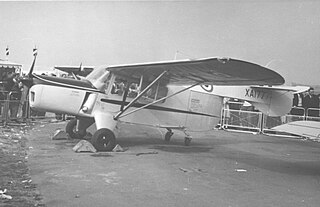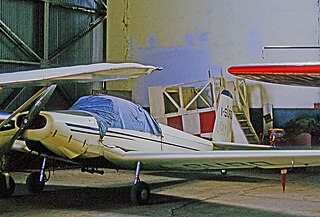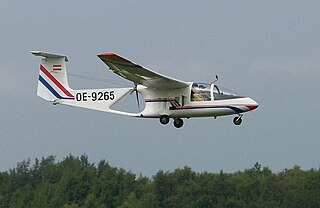
The Aero-Flight Streak was an American two-seat light aircraft built in 1946 by Aero-Flight Aircraft Corporation at Buffalo, New York. Advanced for its time, it was of all-metal construction with tricycle undercarriage, and accommodated the pilot and passenger in tandem beneath a sliding, bubble canopy.

The Agusta A.101 was a large prototype transport helicopter developed in Italy during the 1960s. Despite prospective orders from the Italian armed forces, no buyers emerged and the project was abandoned in 1971.

Aeronáutica Industrial S.A. is a Spanish aeronautical company. The predecessor company, Talleres Loring had been founded by Jorge Loring in 1923.
The AISA GN was a prototype four-seat autogyro developed in Spain between 1971 and 1982. it featured an extensively-glazed cabin fitted with a pusher engine and tricycle undercarriage. A separate tail fin was carried at the end of two booms mounted to stub wings. The prototype was developed with a 200 hp engine. The aircraft suffered from an extremely prolonged development, but finally took to the air on 20 July 1982. In September that year, however, it was damaged in an accident, and development was finally abandoned.

The Auster B.4 was an unusual British development of the Auster family of light aircraft in an attempt to create a light cargo aircraft.

The Aviamilano P.19 Scricciolo was a light civil trainer aircraft built in Italy in the 1960s.

The CAB GY-20 Minicab is a two-seat light aircraft designed by Yves Gardan and built in France by Construction Aeronautiques du Bearn (CAB) in the years immediately following World War II. CAB was formed in 1948 by Yves Gardan, Max Lapoerte and M. Dubouts.
The Boisavia B.260 Anjou was a four-seat twin-engine light aircraft developed in France in the 1950s. It was a low-wing cantilever monoplane of conventional configuration with retractable tricycle undercarriage. Intended by Boisavia as a touring aircraft, it did not find a market and only the single prototype was constructed. At this point, the firm sold the design to SIPA, which modified the design and re-engined it with Lycoming O-360 engines, but found that they could not sell it either. At a time when the twin-engine light plane market was already dominated by all-metal American aircraft, the Anjou's fabric-over-tube construction was something of an anachronism, and all development was soon ceased. Plans to develop a stretched version with three extra seats and Potez 4D engines were also abandoned.

The Brditschka HB-3, HB-21 and HB-23 are a family of motor gliders of unorthodox configuration developed in Austria in the early 1970s.

The Doman LZ-5 was a utility helicopter developed in the United States in the early 1950s by Doman Helicopters Inc. of Danbury, Connecticut. Despite the procurement of international manufacturing agreements, no series production of the aircraft ever occurred, and only three prototypes were built. Two of these were purchased by the United States Army as the YH-31, but eventually becoming VH-31.

The Piel CP-30 Emeraude is an aircraft designed in France in the mid-1950s and widely built both by factories and homebuilders.
The Fletcher FBT-2 was a military trainer aircraft built in the United States in the early 1940s. Although it was never entered production as a trainer, it was ordered in small numbers as a target drone but when that was cancelled played a small part in the development of guided bombs.

The Macchi MB.308, later Aermacchi MB-308, is a light aircraft produced in Italy in the late 1940s.

The IAR-824 was a utility aircraft built in Romania in the 1970s.

The Macchi MB.320 was an Italian cabin monoplane designed and built by Macchi. Only a small number were built.

The GY-80 Horizon is a French four-seat touring monoplane of the 1960s designed by Yves Gardan and built under licence, first by Sud Aviation, and later by that company's SOCATA subsidiary.
The SNCAC Chardonneret were a short series of 1940s French three- and four-seat cabin monoplanes with the same wings and general layout but with different engines.

The AISA I-115 is a low-wing single-engined military primary trainer with tandem seating, which went into service with the Spanish Air Force in 1956. After retirement in 1976 many were sold to civil operators.

The Ambrosini Rondone is an Italian-designed two/three-seat light touring monoplane of the early 1950s.
The Waco Model W Aristocraft was an American four-seat monoplane, the last aircraft designed and built by the Waco Aircraft Company. It had an unusual configuration with an engine mounted at the front driving a pusher propeller at the rear.















